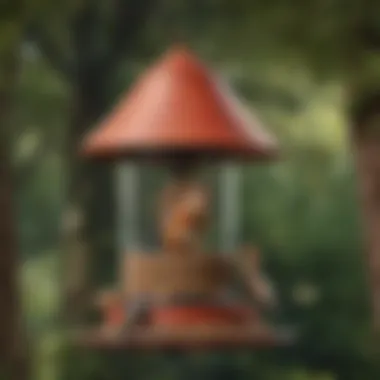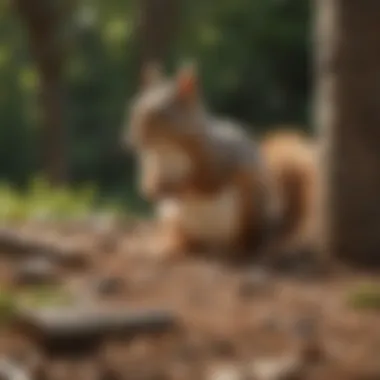Effective Strategies to Keep Squirrels Away: A Comprehensive Guide


What Scares Away Squirrels: An In-Depth Guide to Securing Your Space
Squirrels can be delightful to observe from a distance, but dealing with them invading your home or garden can be a challenge. This comprehensive guide explores effective strategies to prevent squirrels from encroaching on your property. By delving into squirrel behavior and implementing practical deterrents, you can protect your space and enjoy a squirrel-free environment.
Understanding Squirrel Behavior
Before embarking on the journey of deterring squirrels, it's crucial to understand their behavior. Squirrels are naturally curious creatures with a penchant for exploring new territories. They are agile climbers and persistent when seeking food sources. By comprehending these behaviors, you can develop targeted strategies to discourage them from entering your space.
Implementing Deterrents
Once you grasp squirrel behavior, it's time to implement deterrents effectively. From utilizing motion-activated devices to installing barriers, there are various approaches to dissuading squirrels. It's essential to choose methods that align with your space and lifestyle while considering the humane aspect of deterring wildlife.
Scent-based Solutions
- Citrus scents: Squirrels tend to avoid citrus smells, making it an excellent natural deterrent.
- Peppermint oil: The strong scent of peppermint repels squirrels effectively.
- Cayenne pepper: Sprinkling cayenne pepper around your garden can deter squirrels without causing harm.
Physical Barriers
- Wire mesh: Installing wire mesh around vulnerable areas can prevent squirrels from accessing them.
- Roof barriers: Placing barriers on roofs and entry points can limit squirrel entry.
Conclusion
Understanding Squirrel Behavior
Understanding squirrel behavior is crucial when aiming to keep these creatures at bay in domestic environments. By comprehending the habits and patterns of squirrels, homeowners can devise effective strategies to prevent squirrel intrusions. This knowledge enables individuals to anticipate squirrel behavior, identify potential attractants, and implement appropriate deterrent measures.
Squirrel Habits and Patterns
Diurnal Nature of Squirrels
Diurnal nature refers to the behavior of being active during the day and resting at night. Squirrels, being diurnal creatures, are most active in the early morning and late afternoon. This behavior is significant as it allows homeowners to plan deterrent activities during peak squirrel activity hours. By understanding this characteristic, individuals can strategically time the implementation of repellents or physical barriers to maximize their effectiveness.
Foraging Behavior
Foraging behavior is an innate instinct in squirrels driven by the search for food. Squirrels are opportunistic feeders, constantly seeking out food sources in their environment. This behavior influences their movement patterns and preferences for certain areas. Understanding squirrel foraging behavior aids in choosing suitable locations for deterrent placement and identifying potential attractants that may draw squirrels onto the property.
Nesting Preferences
Squirrels exhibit nesting preferences by selecting secure and sheltered locations to build their nests. Trees, attics, and chimneys are commonly favored nesting sites for squirrels. Recognizing these preferences allows homeowners to target specific areas for squirrel-proofing efforts. By addressing these favored nesting spots, individuals can effectively deter squirrels from establishing residences on their property.


Factors Attracting Squirrels
Food Sources
Food sources play a significant role in attracting squirrels to an area. Squirrels are attracted to easily accessible sources of food, such as bird feeders, unsecured trash bins, and uncovered compost piles. By understanding the allure of food sources, homeowners can take proactive measures to eliminate these attractants, making the property less appealing to squirrels.
Shelter Opportunities
Shelter opportunities, including dense vegetation, cluttered spaces, and openings in structures, provide ideal refuge for squirrels seeking shelter. Identifying and securing potential shelter points helps reduce the attractiveness of a property to squirrels. By addressing shelter opportunities, homeowners can significantly decrease the likelihood of squirrel infestations.
Access to Water
A continuous water supply is essential for squirrel survival. Squirrels are drawn to areas with accessible water sources, such as leaky pipes, pet water bowls, and outdoor ponds. Understanding the importance of water access for squirrels enables individuals to disrupt this vital resource, discouraging squirrels from frequenting the property. By limiting access to water, homeowners can create a less hospitable environment for squirrels.
Implementing Physical Deterrents
In the intricate dance of deterring squirrels, the section on Implementing Physical Deterrents plays a pivotal role. This segment delves into practical measures aimed at safeguarding your space from these agile critters. By utilizing physical barriers and repellents, you can establish a protective shield around your property that effectively repels squirrels. The importance of this topic lies in its ability to offer tangible solutions that can be implemented with relative ease, providing a sense of security and tranquility for homeowners and garden enthusiasts alike.
Barrier Methods
Use of Wire Mesh
The deployment of wire mesh presents a formidable obstacle to squirrel incursions, forming a robust defense against these nimble creatures. The key characteristic of wire mesh lies in its durability and versatility as a protective barrier. Its fine yet sturdy construction acts as an impenetrable fortress, effectively thwarting squirrels' attempts at breaching designated areas. A notable advantage of wire mesh is its transparency, blending seamlessly into the surroundings while offering impeccable protection. However, one must consider the installation intricacies and the potential maintenance required for long-term efficacy.
Protective Netting
Protective netting emerges as a safeguarding champion in the battle against squirrel invasions. The main attribute of protective netting is its comprehensive coverage, enveloping vulnerable plants and structures with an impermeable shield. Its flexibility and adaptability make it a favored choice in fortifying gardens and delicate areas from squirrel disturbances. The unique feature of protective netting lies in its ability to provide a safe haven for plants without harming them, ensuring both protection and growth. Despite its efficacy, consideration must be given to regular inspections and replacements to uphold its security standards.
Blockades and Fencing
Introducing blockades and fencing serves as a formidable barrier against squirrel infiltration, setting clear boundaries to safeguard your premises. The key characteristic of blockades and fencing is their robust construction, acting as a steadfast defense against squirrel intruders. Their capability to define territories and restrict access deters squirrels effectively, maintaining a secure environment. A unique feature of blockades and fencing is their versatility in adapting to various landscapes, offering customizable solutions for different settings. However, understanding the intricacies of placement and structural implications is essential to maximize their efficacy over time.
Repellents and Scare Tactics
Among the arsenal of squirrel deterrents, repellents and scare tactics stand out as potent tools in deterring these persistent pests. By leveraging natural repellents, ultrasonic devices, and visual deterrents, homeowners can create an unwelcoming environment that discourages squirrel activity. These methods aim to disrupt squirrels' behavior patterns and reinforce boundaries, contributing to a harmonious coexistence with wildlife.
Natural Repellents
Natural repellents harness the power of organic compounds to repel squirrels effectively without causing harm to the environment. The key characteristic of natural repellents lies in their eco-friendly and non-toxic nature, making them a sustainable choice for deterring squirrels. Their unique feature lies in their scent-based deterrent mechanism, using natural odors to create an unpleasant environment for squirrels. While natural repellents offer a safe and humane solution, their effectiveness may vary depending on environmental factors and squirrel populations.
Ultrasonic Devices


Harnessing cutting-edge technology, ultrasonic devices emit high-frequency sounds that are imperceptible to humans but disruptive to squirrels, deterring them from frequenting specific areas. The key characteristic of ultrasonic devices is their non-intrusive approach, providing a silent yet effective method of squirrel deterrence. Their unique feature lies in their versatility and coverage, capable of safeguarding extensive areas from squirrel intrusions. While ultrasonic devices offer a convenient and automated solution, their placement and maintenance should be optimized for optimal performance.
Visual Deterrents
Visual deterrents leverage optical illusions and predatory cues to dissuade squirrels from lingering in designated zones. The key characteristic of visual deterrents is their simplicity and versatility, relying on visual stimuli to evoke aversion in squirrels. Their unique feature lies in their adaptability to various environments, offering a customizable solution for deterring squirrels effectively. While visual deterrents provide a non-invasive and cost-effective method of squirrel deterrence, their placement and rotation are crucial to prevent habituation.
Modification of Surroundings
In the quest to create an inhospitable environment for squirrels, modifying surroundings plays a crucial role in reinforcing protective measures and minimizing attractants. By implementing strategies such as trimming tree branches, securing trash bins, and removing bird feeders, homeowners can mitigate squirrel interactions and enhance their property's resilience against wildlife intrusions.
Trimming Tree Branches
Trimming tree branches serves as a strategic maneuver to eliminate squirrel highway access points and reduce the proximity of squirrels to vulnerable areas. The key characteristic of this practice is its preventive nature, proactively diminishing potential entryways for squirrels. Its unique feature lies in its ability to maintain landscape aesthetics while ensuring squirrel deterrent efficiency. However, meticulous planning and skilled pruning are essential to optimize the protective benefits of trimming tree branches.
Securing Trash Bins
Securing trash bins bolsters your defenses against squirrel foraging expeditions, curbing their access to potential food sources and reducing attraction to your property. The key characteristic of securing trash bins is its impact on eliminating food incentives for squirrels, fostering a less enticing environment. Its unique feature lies in its immediate effect on deterring squirrel visits and maintaining cleanliness in outdoor spaces. Yet, constant vigilance and secure fastenings are imperative to prevent squirrel breakthroughs and maintain sustained protection.
Removing Bird Feeders
Removing bird feeders acts as a preemptive measure to diminish squirrel foraging opportunities and minimize wildlife enticements near your property. The key characteristic of removing bird feeders is its disruption of the food chain, averting excess squirrel traffic and potential conflicts with bird populations. Its unique feature lies in its dual benefit of deterring squirrels and redirecting avian activity to natural food sources, fostering ecological balance. However, strategic relocation and alternate feeding stations may be considered to mitigate any potential impact on local bird populations and ensure sustainable wildlife cohabitation.
Creating an Unwelcoming Environment
Creating an unwelcoming environment is a crucial aspect when it comes to deterring squirrels. By making your space less attractive to these critters, you can effectively protect your property and maintain peace of mind. When focusing on creating an unwelcoming environment, there are specific elements to consider. Ensuring that your garden is not a favorable spot for squirrels to frequent involves strategic planning and implementation.
Safeguarding Gardens
Use of Raised Beds
The use of raised beds is a key strategy in safeguarding gardens from squirrel invasion. Raised beds elevate plants from ground level, reducing accessibility to squirrels. This method helps protect your plants and flowers, deter squirrels from foraging, and minimizes the chances of damage. The raised height of the beds adds a physical barrier that squirrels find challenging to navigate, making it a popular choice for deterring these pests. However, maintaining the raised beds may require more effort in terms of resources and time.
Mulching Techniques
Mulching techniques contribute significantly to the overall goal of creating an unwelcoming environment for squirrels. Mulch acts as a protective layer around plants, serving as a deterrent for squirrels. The texture and scent of the mulch can discourage squirrels from digging and foraging in your garden. Additionally, mulching helps retain moisture and regulates soil temperature, benefiting the plants while deterring unwanted pests. While effective, proper selection and application of mulch are essential to avoid inadvertent attraction to squirrels.
Plant Selection Strategies
Strategically choosing plants for your garden is a vital part of squirrel deterrence. Opting for plants that squirrels are less likely to be interested in can help safeguard your garden. Researching squirrel-resistant plants and incorporating them into your landscape design can reduce the appeal of your garden to these critters. Plant selection plays a significant role in creating an environment that is uninviting to squirrels while also enhancing the aesthetics of your outdoor space.


Home Maintenance Tips
Sealing Entry Points
Sealing entry points in and around your home is a proactive measure to prevent squirrel intrusion. By closing off potential entryways such as gaps in walls or roofing, you minimize the chances of squirrels gaining access. This method not only deters squirrels but also enhances the energy efficiency of your home while preventing other pests from entering. However, thorough inspection and periodic maintenance are necessary to ensure the effectiveness of this strategy.
Repairing Damaged Areas
Repairing damaged areas in your property is essential for squirrel prevention. Squirrels can exploit even minor structural damages to gain entry into your home or garden. By promptly fixing any wear and tear, you eliminate potential entry points for squirrels. Additionally, repairing damaged areas contributes to the overall maintenance of your property, enhancing its longevity and aesthetic appeal.
Installing Chimney Caps
Installing chimney caps is a practical step in safeguarding your home from squirrel intrusion. Chimneys provide easy access for squirrels to enter your residence, posing a threat to both property and safety. By installing chimney caps, you block off this entry point, preventing squirrels from making their way indoors. Chimney caps also help in preventing debris buildup and potential hazards associated with uncapped chimneys. Regular inspections and maintenance of chimney caps are necessary to ensure long-term effectiveness in deterring squirrels.
Effective Squirrel-Proofing Solutions
In the realm of deterring pesky squirrels, the section of Effective Squirrel-Proofing Solutions emerges as a pivotal component in fortifying your property against unwelcome furry visitors. By delving into the facets of this article, one can grasp the necessity of crafting an impregnable defense system tailored against squirrel intrusions. The relevance of honing in on squirrel-proofing strategies ensures that your living space remains untouched by these critters, thereby guaranteeing tranquility and peace of mind amidst nature's unpredictable allure.
Professional Exclusion Services
Hiring Pest Control Experts:
Within the domain of Professional Exclusion Services, the employment of Pest Control Experts plays a significant role in combating squirrel invasions effectively. Hiring these professionals entails entrusting your squirrel predicament to trained individuals adept at handling such wildlife challenges. The characteristic finesse of Pest Control Experts lies in their nuanced understanding of squirrel behavior and habitat preferences, empowering them to devise tailored solutions to eradicate these nuisances comprehensively. Opting for the expertise of Pest Control Experts proves to be a pragmatically sound choice within the context of this article, offering a reliable and efficient approach to squirrel deterrence.
Sealing Off Potential Entryways:
As part of the strategy to repel squirrels, sealing off potential entryways emerges as a quintessential tactic in fortifying your property defenses. The pivotal characteristic of this method rests in its proactive approach to preemptively obstruct squirrel access points, thereby thwarting their entry effectively. By fortifying vulnerable areas through adept sealing measures, homeowners can significantly reduce the likelihood of squirrel intrusions, fostering a secure environment free from unwarranted wildlife disruptions. While this method champions a proactive stance against squirrel encroachment, it's imperative to assess the advantages and disadvantages within the context of this article's overarching goal.
Implementing Long-Term Solutions:
The endeavor of Implementing Long-Term Solutions underlines a strategic initiative aimed at sustaining a squirrel-free environment over extended periods. This facet accentuates the need for adopting holistic approaches that address the root causes of squirrel attractions, thereby deterring them in the long run. The key characteristic of long-term solutions lies in their enduring efficacy, offering a sustainable shield against recurring squirrel infiltrations. Embracing these durable strategies ensures a prolonged reprieve from squirrel disturbances, underscoring the strategic advantage they provide within the narrative framework of this article.
Collaborative Community Efforts
In the collaborative tapestry of deterring squirrels, the segment on Collaborative Community Efforts weaves together collective actions aimed at safeguarding shared spaces from rampant squirrel intrusions. Fostering communication among neighbors and instituting shared pest control measures signifies a communal commitment to mitigating squirrel incursions, resonating with the overarching theme of maintaining harmonious coexistence amidst urban wildlife prevalence. Each aspect within this section embodies the spirit of communal synergy, advocating for concerted efforts towards efficient squirrel management within community settings.
Neighbor Communication:
Central to the ethos of Collaborative Community Efforts, Neighbor Communication serves as a linchpin in fortifying neighborly bonds and fostering united fronts against squirrel infestations. The characteristic essence of Neighbor Communication lies in its ability to galvanize collective vigilance among community members, promoting timely information exchange on squirrel sightings and behavioral patterns. Embracing this form of communication bolsters neighborhood solidarity, empowering residents to act collaboratively in deterring common threats posed by squirrels, thereby enriching the communal fabric.
Shared Pest Control Measures:
A pivotal component of community-driven squirrel deterrence, Shared Pest Control Measures epitomize a unified approach towards implementing cohesive strategies that resonate with the article's central theme. The key characteristic underscoring Shared Pest Control Measures lies in their collaborative nature, advocating for shared responsibilities and coordinated actions among community stakeholders. By pooling resources and knowledge, communities can bolster their defenses against squirrel intrusions, establishing a fortified frontline against these persistent pests, in alignment with the overarching narrative of fostering collective resilience.
Community Wildlife Management:
The strategic initiative of Community Wildlife Management delineates a vested interest in coalescing community resources and expertise towards implementing sustainable solutions for addressing squirrel incursions collaboratively. The distinctive feature of Community Wildlife Management manifests in its holistic approach to wildlife preservation and pest control, underscoring an integrative strategy that harmonizes human habitats with natural ecosystems. Embracing this facet promotes ecological balance while fortifying communal resilience against squirrel disruptions, accentuating its multifaceted advantages poised to benefit the collective community within the purview of this article's narrative landscape.







